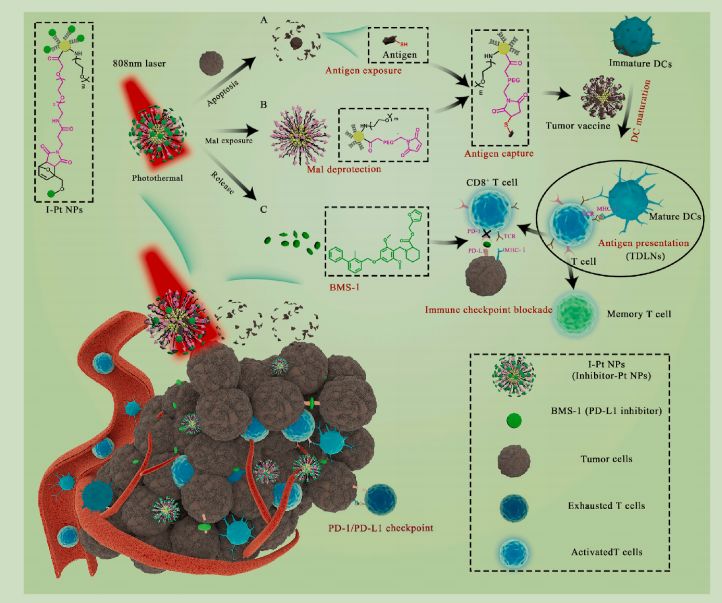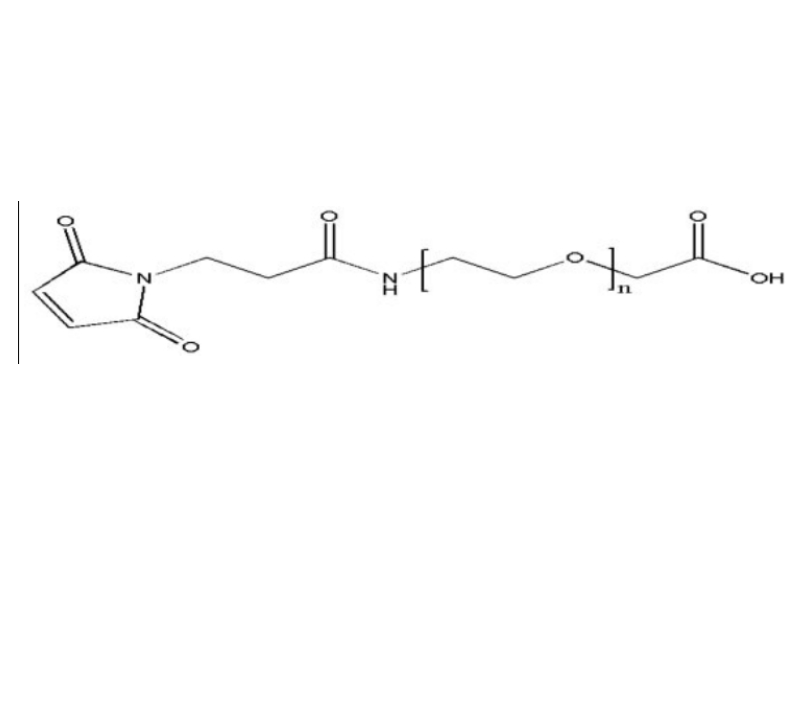文献:Synergistic enhancement of immunological responses triggered by hyperthermia sensitive Pt NPs via NIR laser to inhibit cancer relapse and metastasis
文献链接:https://www.sciencedirect.com/science/article/pii/S2452199X21002504
作者:Jie Yu, Sha Liu,Yupeng Wang,Xidong He,Qingfei Zhang,Yanxin Qi , Dongfang Zhou, Zhigang Xie , Xiaoyuan Li, Yubin Huang
相关产品:
Mal-PEG2k-COOH 马来酰亚胺-聚乙二醇2k-羧基
BMS-1
原文摘要:The combination of tumor ablation and immunotherapy is a promising strategy against tumor relapse and metastasis. Photothermal therapy (PTT) triggers the release of tumor-specific antigens and damage associated molecular patterns (DAMPs) in-situ. However, the immunosuppressive tumor microenvironment restrains the activity of the effector immune cells. Therefore, systematic immunomodulation is critical to stimulate the tumor microenvironment and augment the anti-tumor therapeutic effect. To this end, polyethylene glycol (PEG)-stabilized platinum (Pt) nanoparticles (Pt NPs) conjugated with a PD-L1 inhibitor (BMS-1) through a thermosensitive linkage were constructed. Upon near-infrared (NIR) exposure, BMS-1 was released and maleimide (Mal) was exposed on the surface of Pt NPs, which captured the antigens released from the ablated tumor cells, resulting in the enhanced antigen internalization and presentation. In addition, the Pt NPs acted as immune adjuvants by stimulating dendritic cells (DCs) maturation. Furthermore, BMS-1 relieved T cell exhaustion and induced the infiltration of effector T cells into the tumor tissues. Thus, Pt NPs can ablate tumors through PTT, and augment the anti-tumor immune response through enhanced antigen presentation and T cells infiltration,
thereby preventing tumor relapse and metastasis.
Mal-PEG2k-COOH是一个复合物的名称,由马来酰亚胺(Maleimide,Mal)、聚乙二醇(polyethylene glycol,PEG,2k表示其平均分子量约为2千道尔顿)和羧基(COOH)结合而成。BMS-1 在细胞生物学研究领域有着重要作用,通过与细胞内的信号分子相互作用,影响细胞的分化、迁移、增殖等行为。例如,它可以激活某条与细胞生长相关的信号通路,促使干细胞向特定类型的细胞分化,这对于再生医学领域中组织器官的修复和再生研究有着重要意义。Mal-PEG2k-COOH 和 BMS-1 在 BMS-1-PEG2k-COOH 的制备中都有着不可或缺的作用,它们各自发挥自身的结构和化学性质优势,相互配合来构建出具有特定功能和应用价值的目标产物。

图为:Pt NPs通过热敏感连接结合BMS-1结合NIR控制抑制剂释放和Mal暴露的示意图
Mal-PEG2k-COOH和BMS-1在BMS-1-PEG2k-COOH制备的应用:
将RhB、糠醇、DCC和DMAP加入无水聚合瓶中,用无水二氯甲烷溶解。在室温下保持反应。加入一滴水终止反应,将DCC转化为DCU,通过冷冻过滤去除。用冷醚沉淀和过滤得到呋喃基RhB。用1 H NMR和ESI-MS对糠酰RhB进行了表征,并得到了糠酰BMS-1。将Mal-PEG2k-COOH和糠基RhB混合并溶解在无水二氯甲烷中。在室温下保持反应。旋转蒸发后,产物用水溶解,透析,去除未反应的糠基RhB。所得的RhB-PEG2k-COOH(RPEG2k-COOH)通过1 H NMR进行了表征。将Mal-PEGCOOH与糠基BMS-1结合,得到BMS-1-PEG2k-COOH(I-PEG2k-COOH)。

图为:Mal-PEG2k-COOH结构式
结论:在制备 BMS-1-PEG2k-COOH 的过程中,Mal-PEG2k-COO中的PEG2k 链有助于将 BMS-1 与羧基以合适的距离连接起来,避免二者相互干扰,同时让最终产物在不同的溶剂体系尤其是水性环境中有更好的分散性和稳定性,更利于后续的应用。BMS-1 需要具备合适的反应基团或者能够通过化学修饰引入相应的反应基团,从而与 Mal-PEG2k-COOH 发生化学反应以构建目标产物。

 2025-08-29 作者:lkr 来源:
2025-08-29 作者:lkr 来源:

